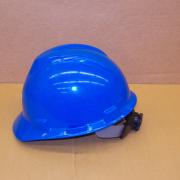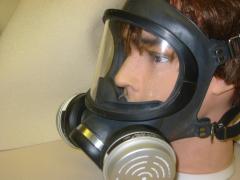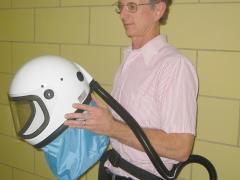
(Source: Penn State Ag Safety and Health)
Use the following format to cite this article:
Heat-related illnesses and agricultural producers. (2024) Ag Safety and Health eXtension Community of Practice. Retrieved from https://ag-safety.extension.org/heat-related-illnesses-and-agricultural-producers/.
Farmers and ranchers perform job responsibilities in all types of weather conditions including excessive heat and humidity. It is important for agricultural producers to understand risks associated with working in high heat work environments, potential heat-related illnesses, precautionary steps, and appropriate medical responses.
Understanding the Body’s Response to Heat
Our body’s primary defense against heat is through sweating. Sweating allows moisture to collect on the skin and evaporate. Sweating happens when the surrounding environment becomes greater than skin temperature. When this occurs, an internal body system called the sympathetic nervous system releases a chemical called acetylcholine which turns on sweat glands in the skin in an area called the dermis. The sweat glands release moisture and move it to the outer surface of the skin for cooling. However, in hot, humid weather, the moisture does not always evaporate and can collect on the skin causing the body to warm up and the heart to pump more blood to the skin. When this happens, the body starts to sweat excessively and depletes the body of water and electrolytes, which can lead to a heat-related illness.
The range for normal body temperature is between 96° to 100°F. Hard exercise, strenuous work, or fever will usually put the body in a range between 101° to 105°F. At 105° to 107°F, cooling treatment or fever therapy may be needed, and at even higher body temperatures, heat exhaustion and heat stroke usually occur. Heat exhaustion and heat stroke indicate a serious impairment to the body’s cooling system and is a definite signal for medical assistance. Heat stroke or body temperatures beyond 110°F may result in death.
Risk Factors for Heat-Related Illnesses
Everyone is at risk for heat-related illness if they do not follow standard precautionary measures. The following factor(s) can increase the chance for developing one of the five main heat-related illnesses:
- Being elderly or an infant.
- Having certain medical conditions such as circulatory problems, heart conditions, or pregnancy.
- Being physically unfit or overweight.
- Consuming alcohol and/or drugs (including prescription medication; for example. the medication atropine interferes with the ability to sweat).
- Having lower heat tolerance levels or not becoming acclimated to working in high heat and humidity.
- High temperatures and humidity levels in the environment (as well as sun radiation or heat-conducting surfaces like black asphalt).
- Not having adequate fluid intake levels needed to hydrate the body.
- Limited air flow or breeze to aid in the cooling process.
Breakdown of Common Heat-Related Illnesses
There are five heat-related illnesses: heat rash, syncope, cramps, exhaustion, and stroke. Heat exhaustion and heat stroke are typically the most severe and require immediate medical attention. Figure 1 outlines each illness, typical symptoms, and treatment.
| Heat-Related Illnesses | Cause | Symptoms | Treatment |
| Heat rash | Excessive sweating during humid weather | Red, blotchy skin rash; clusters of pimples or small blisters | Keep the affected area dry, and treat with cornstarch or powder. Work in a cooler, less humid work environment. |
| Heat syncope | Prolonged standing or rising suddenly from a sitting or lying position | Light-headedness, dizziness, or fainting | Move person to a cool place to lie down, elevate the feet, and give liquids to drink. |
| Heat cramps | Loss of body salts and fluids from sweating during strenuous activity | Pain in stomach, arms, and/or legs | Stop activity, drink clear or sports beverage. Massage affected muscles. |
| Heat exhaustion | Excessive loss of body salts and water from sweating | Cool, pale skin, dizziness, headache, cramps, nausea, sweating, weakness, confusion, high body temperature, and unconsciousness | Have the person drink plenty of cool fluids, remove excess clothing, and apply cool compresses. Call for medical attention. |
| Heat stroke | System that regulates body temperature fails and the body temperature rises to critical levels | High temperature, hot dry skin, slurred speech, confusion, loss of consciousness, and seizures | Immediately call for medical assistance. Move the person to a cool place, and slightly elevate the head and shoulders. Remove outer clothing, and cool the body with water, wet towels, or sheets. |
Recommendations to Avoid Heat-Related Problems
- Do not wait until you are thirsty – drink approximately 8 oz. (1 cup) of water every 15 to 30 minutes.
- Take a 15-minute break in a shaded area every two hours.
- Monitor the weather, and schedule strenuous work activities accordingly to reduce exposure to high heat situations.
- Wear light-colored, lightweight, and loose-fitting clothing.
- Avoid the use of alcohol, drugs, caffeine, and large amounts of sugar when exposed to heat because they can increase your rate of dehydration.
- Check your prescriptions and over-the-counter medications to determine if there are any side effects when you are exposed to heat.
- Appropriately wear specialized protective gear such as cooling vests to reduce your risk of a heat illness; if used inappropriately, heat illness can actually increase.
- Learn about prevention of heat illness and teach your workers about health and safety instructions related to working in hot weather and appropriate responses to heat-related illnesses.
- Gradually build up a tolerance to working in the heat. If a person has a severely low tolerance to heat, that person may need to perform tasks that limit exposure to the heat.
- Certain types of personal protective equipment (PPE) can increase the risk of heat stress, such as protective suiting. Schedule jobs that require PPE during cooler times of the day.
- Recognize the conditions that can affect body heat such as fever, physically strenuous work, and even time of day (for example, body temperature is higher in late afternoons).
- Talk to your physician if you have a chronic health condition or disability (e.g., spinal cord injuries, multiple sclerosis) before working in the heat.
View the U.S. Agricultural Safety and Health Centers video below to learn about the risk of heat-related illnesses for outdoor workers.
Additional Resources:
Beat the Heat by Upper Midwest Agricultural Safety and Health (UMASH)
Heat Illness and Agriculture by Penn State Extension
Use the following format to cite this article:
Heat-related illnesses and agricultural producers. (2024) Ag Safety and Health eXtension Community of Practice. Retrieved from https://ag-safety.extension.org/heat-related-illnesses-and-agricultural-producers/.
Sources
Heat stress. (2022). Centers for Disease Control and Prevention. Retrieved from https://www.cdc.gov/niosh/topics/heatstress/heatrelillness.html.
Jepsen, S.D., McGuire, K. & Poland, D. (2011) Secondary injury prevention: Heat stress. The Ohio State University. Retrieved from http://ohioline.osu.edu/factsheet/AEX-981.4-10.
Murphy, D. & Fetzer, L. (2024.). Heat illness and agriculture. Pennsylvania State University College of Agricultural Science Cooperative Extension. Retrieved from https://extension.psu.edu/heat-illness-and-agriculture.
Porth, C.M. (2010). Pathophysiology, 8th ed. Lippincott-Williams.
Protecting workers from the effects of heat. (2023). Occupational Safety and Health Administration Fact Sheet. Retrieved from https://www.osha.gov/sites/default/files/publications/OSHA3743.pdf.












